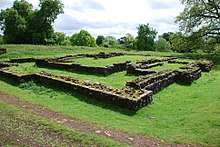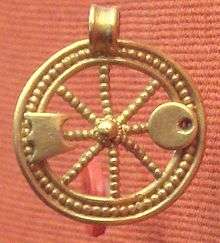Nodens
Nodens (Nudens, Nodons) is a Celtic deity associated with healing, the sea, hunting and dogs. He was worshipped in ancient Britain, most notably in a temple complex at Lydney Park in Gloucestershire, and possibly also in Gaul. He is equated with the Roman gods Mars, Neptune and Silvanus, and his name is cognate with that of the Irish mythological figure Nuada and the Welsh Nudd.[1][2]

Etymology
The name Nodens probably derives from a Celtic stem *noudont- or *noudent-, which J. R. R. Tolkien suggested was related to a Germanic root *neut- meaning "acquire, have the use of", earlier "to catch, entrap (as a hunter)" (cf. Proto-Germanic *neut-e- "to make use of, to enjoy", *naut-a- "benefit, profit; possession; livestock, cattle"). Making the connection with Nuada and Lludd's hand, he detected "an echo of the ancient fame of the magic hand of Nodens the Catcher".[3] Similarly, Julius Pokorny derives the name from a Proto-Indo-European root *neu-d- meaning "acquire, utilise, go fishing".[4] Ranko Matasović has proposed that the name of this deity may come from Proto-Celtic *snoudo-, meaning "mist, clouds". According to his proposal, the transition from *snoudo- to Nodons happened because the particle sN was changed to N in P-Celtic languages, such as Gaulish and Brittonic. Furthermore, Nodons' name – which is in the nominative case – appears in inscriptions as Nodontī due to a change to the dative case. However, sN- was not reduced in Old Irish, in which the cognate is attested as Núada ~ Núadat, not *Snúada, which evidence weakens Matasović's derivation.
Centres of worship

The Lydney Park complex
The temple complex at Lydney Park, situated on a steep bluff overlooking the Severn Estuary, is rectangular, measuring 72 by 54 m (236 by 177 ft), with a central cella measuring 29 by 49.5 m (31.7 by 54.1 yd), and its north-western end is divided into three chambers 6.3 m deep. This imposing, Romano-Celtic temple building has been interpreted as an incubatio or dormitory for sick pilgrims to sleep and experience a vision of divine presence in their dreams. The site may have been chosen because it offered a clear view of the River Severn near the point at which the Severn Bore begins. Its position within an earlier Iron Age hill fort must also be relevant.[5]
The complex was archeologically excavated in the 1920s by Tessa Wheeler and her husband Mortimer Wheeler.[6] It has produced several inscriptions to Nodens. One, on a lead curse tablet, reads:
DEVO NODENTI SILVIANVS ANILVM PERDEDIT DEMEDIAM PARTEM DONAVIT NODENTI INTER QVIBVS NOMEN SENICIANI NOLLIS PETMITTAS SANITATEM DONEC PERFERA VSQVE TEMPLVM DENTIS
For the god Nodens. Silvianus has lost a ring and has donated one-half [its worth] to Nodens. Among those named Senicianus permit no good-health until it is returned to the temple of Nodens.[7]
It is conjectured that this lost ring is the ring of Silvianus found in the 19th century far away from Lydney.
Another, on a bronze plate, identifies Nodens with the Roman god Mars:
D M NODONTI FLAVIVS BLANDINVS ARMATVRA V S L M
To the god Mars Nodons, Flavius Blandinus the drill-instructor willingly and deservedly fulfills his vow.
Another plate, bearing the image of a baying hound, makes the same equation:
PECTILLVS VOTVM QVOD PROMISSIT DEO NVDENTE M DEDIT
Pectillus dedicates this votive offering which he had promised to the god Nudens Mars.
There is also evidence of at least one temple priest. The cella has a mosaic floor, the surviving fragments of which depict dolphins, fish and sea monsters. The floor dates to the 4th century and was dedicated to the temple of Nodens by one Titus Flavius Senilis. The artifacts recovered include a bronze object, which may be a headdress or a vessel, showing a sea-god driving a chariot between torch-bearing putti and tritons. Miranda Green speculates that Senilis may have been the individual who wore this artifact.[5]
Other artifacts include bronze reliefs depicting a sea deity, fishermen and tritons, nine stone or bronze statues of dogs, one of which has a human face, and some of which are similar to Irish Wolfhounds, a bronze plaque of a woman, a bronze arm, an oculist's stamp (used by physicians to mark their cakes of eye ointment), about 320 pins, nearly 300 bracelets,[8] and over 8,000 coins. The iconography shows a clear association with the sea, while the dogs, pins and bracelets and bronze arm, which shows signs of disease, indicate a healing function: the dog is a companion of the healing aspect of Mars, and dogs were symbols of healing throughout the classical world and Celtic world because they were observed to heal their own wounds by licking them. Images of pilgrims and deities holding dogs occur at many Gaulish spring sanctuaries; and live sacred dogs were kept at the temple of Asclepius at Epidaurus in the Peloponnese. The pins are associated with childbirth. The dogs, and the equating of Nodens with Silvanus, also suggest a connection with hunting.[2][5][9]
According to Cook,[10] the toponym Lydney derives from the Old English *Lydan-eġ, ‘Lludd's Island.' However, alternative etymologies of Lydney are offered in other sources.
Others
A silver statuette found at Cockersand Moss, Lancashire, in 1718 but now lost, had an inscription on the base which read:
LVCIANVS • D M N • COL LIC APRILI VIATO • RIS V S
To the god Mars Nodontis, the College of Lictors [and] Lucianus Aprilis the traveller, in fulfilment of a vow
Another inscription from Vindolanda on Hadrian's Wall reads "DEO NO/NEPTU", which has been interpreted as "To the god Nodens Neptune".
The god Noadatus, equated with Mars in an inscription found at Mainz in Germany (which was in Gaul in Roman times) may be the same deity.[2]
The placename Maynooth, a town in north Co. Kildare, Ireland, is an anglicisation of "Magh Núad", which means "[the] plain of Núadu".
The surnames Ó Nuadhain, Noon/Noone, and Noonan
The Gaelic-Irish surname Ó Nuadhain (anglicised as Noon or Noone) is believed to derive from the forename Nuadha. Found particularly in County Galway, County Mayo and County Roscommon, the family were a sept of the Uí Fiachrach who settled in Cálraighe, in what is now County Sligo.[11] It is distinct from Ó Nuanáin (found in north County Cork and County Limerick), which is a corruption of Ó hIonmhaineáin; both are now anglicised as Noonan.[11]
Mythological parallels
The name Nodens is cognate with Old Irish Nuada, an important figure from the Irish Mythological Cycle. Nuada was the first king of the Tuatha Dé Danann, who was disqualified from kingship after losing his hand (or arm) in battle, but restored after he was given a working silver one by the physician Dian Cecht and the wright Creidhne (gaining the epithet Airgetlám, "silver hand"), and later a flesh and blood one by Dian Cecht's son Miach. The Norse god Týr is another deity equated with Mars who lost a hand.[12]
The Welsh Nudd is also cognate, and it is likely that another Welsh figure, Lludd Llaw Eraint (Lludd of the Silver Hand), derives from Nudd Llaw Eraint by alliterative assimilation.[13] The legendary British king Lud may therefore ultimately be derived from Nodens, traditionally associated with the city of London / Londinium (see Ludgate). The Fisher King of Arthurian legend is therefore proposed as a survival of this deity.
A similar figure is Njord of the Vanir, Norse god of wind, fertile land along the seacoast, as well as seamanship, sailing and fishing, whom the prose Edda also associates with the power to calm the sea or fire.
In fiction
In H. P. Lovecraft's novella The Dream-Quest of Unknown Kadath (1926), Nodens is an "archaic" god served by the nightgaunts. He is depicted as somewhat benevolent and as opposing the frightening Nyarlathotep. Nodens appears again in Lovecraft's "The Strange High House in the Mist" which mentions "...the grey and awful form of primal Nodens, Lord of the Great Abyss."

Tolkien, invited to investigate the Latin inscription at Lydney Park, traced Nodens to the Irish hero Nuada Airgetlám, "Nuada of the Silver-Hand".[3] The Tolkien scholar Tom Shippey thought this a "pivotal" influence on Tolkien's invention of Middle-earth, combining as it did a god-hero, a ring, dwarves, and a silver hand.[14] The J.R.R. Tolkien Encyclopedia notes also the "Hobbit-like appearance of [Dwarf's Hill]'s mine-shaft holes", and that Tolkien was extremely interested in the hill's folklore on his stay there, citing Helen Armstrong's comment that the place may have inspired Tolkien's "Celebrimbor and the fallen realms of Moria and Eregion".[14][15] The name of the Elven-smith Celebrimbor of Eregion, who forged the Rings of Power in The Silmarillion, means "Silver Hand" in Tolkien's invented Elvish language of Sindarin. Dwarf's Hill with its many mineshafts has been suggested as an influence on the Lonely Mountain in The Hobbit and the Mines of Moria in The Lord of the Rings.[16]
In Laurell K. Hamilton's Mistral's Kiss in the Merry Gentry series, the character Doyle is revealed to have once been Nodons, "a god of healing". One of Doyle's other forms is a dog, and his lick has the ability to cure minor wounds. In Doranna Durgin's 2001 novel A Feral Darkness, Nodens (Referred to as "Mars Nodens") plays a crucial role throughout the book. Brian Keene's 2006 novel Dark Hollow utilizes Nodens as an outer deity, one of thirteen separate from God's Heaven and Hell, and as ruler of a realm known as the Labyrinth. Keene's Nodens is the father to Pan, and the Labyrinth is the realm satyrs hail from in this work. John Lambshead's 2013 fantasy short story "Haunts of Guilty Minds" includes the God Nodens, also referred to as Nud, as a primary antagonist and villain.
References
- James MacKillop, Dictionary of Celtic Mythology, Oxford: OUP, 1998, p. 306
- Dyfed Lloyd Evans, Nudd/Lludd/Nodons, Nemeton Archived 29 August 2006 at the Wayback Machine, 2005, retrieved 3 March 2007
- J. R. R. Tolkien, "The Name Nodens", Appendix to "Report on the excavation of the prehistoric, Roman and post-Roman site in Lydney Park, Gloucestershire", Reports of the Research Committee of the Society of Antiquaries of London, 1932; also in Tolkien Studies: An Annual Scholarly Review, Vol. 4, 2007
- Julius Pokorny, Indogermanisches etymologisches Wörterbuch 768
- Green, Miranda J. (2005) Exploring the world of the druids. London: Thames & Hudson. ISBN 0-500-28571-3. p. 119
- Wheeler, R. E. M; Wheeler, T. V. (1932). Report on the Excavation of the Prehistoric, Roman, and Post-Roman Site in Lydney Park, Gloucestershire. Reports of the Research Committee of the Society of Antiquaries London. IX. Society of Antiquaries.
- "Lydney". Curse Tablets from Roman Britain. Centre for the Study of Ancient Documents. Archived from the original on 14 October 2017. Retrieved 14 October 2017.
- In fact, over 270 bracelets with many more suggested to be in private ownership. As the findings attested metalworking at Lydney so it could be assumed that the bracelets were produced on-site (Ellen Swift, Roman Dress Accessories, Princes Risborough: Shire Publications, 2003, p. 10ff.).
- "Lydney Park Temple Complex" Archived 28 March 2007 at the Wayback Machine and "The Gods of Roman Britain", Roman-Britain.org
- Cook, Arthur Bernard (1906). "The European Sky-God. IV. The Celts" in Folklore, Vol. 17, No. 1 (25 March, pp. 27–71).
- Irish Ancestors/ Surnames
- Mary Jones, "Nodens" Archived 13 July 2007 at the Wayback Machine, Jones' Celtic Encyclopedia Archived 8 June 2008 at the Wayback Machine
- James Mackillop, Dictionary of Celtic Mythology, 1998, p. 266
- Anger, Don N. (2013) [2007]. "Report on the Excavation of the Prehistoric, Roman and Post-Roman Site in Lydney Park, Gloucestershire". In Drout, Michael D. C. (ed.). J.R.R. Tolkien Encyclopedia: Scholarship and Critical Assessment. Routledge. pp. 563–564. ISBN 978-0-415-86511-1.
- Armstrong, Helen (May 1997). "And Have an Eye to That Dwarf". Amon Hen: The Bulletin of the Tolkien Society (145): 13–14.
- Bowers, John M. (2019). Tolkien's Lost Chaucer. Oxford University Press. pp. 131–132. ISBN 978-0-19-884267-5.
External links


